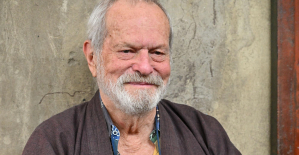In 2021, more than every third pensioner in Germany drew a pension below the basic security level. According to the Federal Ministry of Labor (BMAS), this was 853 euros in 2021. The benefits paid out for around 6.8 million pensioners were below this limit.
In relation to the total of 18.5 million retirees in 2021, this corresponds to a share of 37 percent. These numbers come from an answer to a request from the AfD parliamentary group in the Bundestag, which WELT has exclusively.
In the figures provided by the Department of Labour, there is a significant difference between men and women. For 5.2 million of the total of 10.3 million old-age pensioners - i.e. more than every second recipient - the pension in 2021 was below 853 euros.
In contrast, almost 1.6 million of the total of 8.2 million men received a pension below the threshold, which corresponds to around 19 percent.
There is also a clear gap in the amounts. The average pension payment amount for men who drew an old-age pension was 1227 euros in 2021 - for women, on the other hand, it was only 807 euros.
"Women in particular have to make ends meet with absurdly low pensions," says René Springer, labor market policy spokesman for the AfD parliamentary group. Family work should under no circumstances lead to poverty in old age, according to the MP.
"The available figures show very clearly that the statutory pension no longer fulfills the eminently important function of effectively combating poverty in old age," says Matthias W. Birkwald, spokesman for pension policy for the left-wing faction. "We need a rapid increase in the pension level from 48 to 53 percent that ensures a standard of living."
It is by no means clear from the figures that more than one in three pensioners is poor or at risk of poverty. According to the Federal Ministry of Labor and Social Affairs, a low old-age pension cannot generally be inferred from a low old-age income.
"Not every pension that is below the basic security level is an indication that the pensioner lives below the basic security level," says Tanja Machalet (SPD), a member of the Committee on Labor and Social Affairs.
Stephan Stracke, labor market policy spokesman for the CSU parliamentary group, has a more differentiated interpretation. “Only the number of recipients of basic security in old age can provide information about poverty in old age. Their share is currently around 3.2 percent - in the total population, on the other hand, a significantly higher proportion is in need," says Stracke.
"Even if the problem is not as big as the AfD would like it to be, we still have too many older people who are dependent on basic security benefits." The goal must be a noticeable increase in pensions for future generations.
It is also difficult to draw conclusions about poverty in old age because the figures do not take into account that two people usually contribute to the household income. In order to identify an actual risk of poverty, "the households and the total income from old age must be taken into account," says Pascal Kober, spokesman for the FDP parliamentary group on labor market policy.
For example, one spouse's pension payment amount can be significantly lower than that of the other. In addition, the figures say nothing about any private provisions and assets, widows' pensions, professional pensions or home ownership.
The responsible state secretary in the BMAS also points out that with low pensions there are often entitlements in other security systems, such as civil servant pensions. According to the AfD faction, however, this number only accounts for a small proportion.
According to the ministry’s old-age security report, in 2020 a total of 27 percent of former civil servants, judges and soldiers had entitlements from statutory pension insurance in addition to their civil servant pensions.
In relation to the approximately 1.4 million pension recipients in the federal, state and local governments, this means that almost 378,000 people are entitled to an additional pension. Calculated on the 6.8 million old-age pensioners who draw a pension below the basic security threshold, this corresponds to a share of only 5.6 percent.
The figures also show that 1.25 million pensioners were working at the end of 2021. Those persons who paid contributions to the pension insurance were recorded.
However, it should be taken into account that gainful employment after retirement age is "usually not carried out to avoid poverty", according to the ministry.
In addition to financial reasons, the main reasons for employment after reaching the statutory retirement age are also non-material aspects. "These include, for example: having fun at work, contact with other people or the feeling of being needed."
"Everything on shares" is the daily stock exchange shot from the WELT business editorial team. Every morning from 5 a.m. with the financial journalists from WELT. For stock market experts and beginners. Subscribe to the podcast on Spotify, Apple Podcast, Amazon Music and Deezer. Or directly via RSS feed.

 United States: divided on the question of presidential immunity, the Supreme Court offers respite to Trump
United States: divided on the question of presidential immunity, the Supreme Court offers respite to Trump Maurizio Molinari: “the Scurati affair, a European injury”
Maurizio Molinari: “the Scurati affair, a European injury” Hamas-Israel war: US begins construction of pier in Gaza
Hamas-Israel war: US begins construction of pier in Gaza Israel prepares to attack Rafah
Israel prepares to attack Rafah First three cases of “native” cholera confirmed in Mayotte
First three cases of “native” cholera confirmed in Mayotte Meningitis: compulsory vaccination for babies will be extended in 2025
Meningitis: compulsory vaccination for babies will be extended in 2025 Spain is the country in the European Union with the most overqualified workers for their jobs
Spain is the country in the European Union with the most overqualified workers for their jobs Parvovirus alert, the “fifth disease” of children which has already caused the death of five babies in 2024
Parvovirus alert, the “fifth disease” of children which has already caused the death of five babies in 2024 Falling wings of the Moulin Rouge: who will pay for the repairs?
Falling wings of the Moulin Rouge: who will pay for the repairs? “You don’t sell a company like that”: Roland Lescure “annoyed” by the prospect of a sale of Biogaran
“You don’t sell a company like that”: Roland Lescure “annoyed” by the prospect of a sale of Biogaran Insults, threats of suicide, violence... Attacks by France Travail agents will continue to soar in 2023
Insults, threats of suicide, violence... Attacks by France Travail agents will continue to soar in 2023 TotalEnergies boss plans primary listing in New York
TotalEnergies boss plans primary listing in New York La Pléiade arrives... in Pléiade
La Pléiade arrives... in Pléiade In Japan, an animation studio bets on its creators suffering from autism spectrum disorders
In Japan, an animation studio bets on its creators suffering from autism spectrum disorders Terry Gilliam, hero of the Annecy Festival, with Vice-Versa 2 and Garfield
Terry Gilliam, hero of the Annecy Festival, with Vice-Versa 2 and Garfield François Hollande, Stéphane Bern and Amélie Nothomb, heroes of one evening on the beach of the Cannes Film Festival
François Hollande, Stéphane Bern and Amélie Nothomb, heroes of one evening on the beach of the Cannes Film Festival Skoda Kodiaq 2024: a 'beast' plug-in hybrid SUV
Skoda Kodiaq 2024: a 'beast' plug-in hybrid SUV Tesla launches a new Model Y with 600 km of autonomy at a "more accessible price"
Tesla launches a new Model Y with 600 km of autonomy at a "more accessible price" The 10 best-selling cars in March 2024 in Spain: sales fall due to Easter
The 10 best-selling cars in March 2024 in Spain: sales fall due to Easter A private jet company buys more than 100 flying cars
A private jet company buys more than 100 flying cars This is how housing prices have changed in Spain in the last decade
This is how housing prices have changed in Spain in the last decade The home mortgage firm drops 10% in January and interest soars to 3.46%
The home mortgage firm drops 10% in January and interest soars to 3.46% The jewel of the Rocío de Nagüeles urbanization: a dream villa in Marbella
The jewel of the Rocío de Nagüeles urbanization: a dream villa in Marbella Rental prices grow by 7.3% in February: where does it go up and where does it go down?
Rental prices grow by 7.3% in February: where does it go up and where does it go down? Even on a mission for NATO, the Charles-de-Gaulle remains under French control, Lecornu responds to Mélenchon
Even on a mission for NATO, the Charles-de-Gaulle remains under French control, Lecornu responds to Mélenchon “Deadly Europe”, “economic decline”, immigration… What to remember from Emmanuel Macron’s speech at the Sorbonne
“Deadly Europe”, “economic decline”, immigration… What to remember from Emmanuel Macron’s speech at the Sorbonne Sale of Biogaran: The Republicans write to Emmanuel Macron
Sale of Biogaran: The Republicans write to Emmanuel Macron Europeans: “All those who claim that we don’t need Europe are liars”, criticizes Bayrou
Europeans: “All those who claim that we don’t need Europe are liars”, criticizes Bayrou These French cities that will boycott the World Cup in Qatar
These French cities that will boycott the World Cup in Qatar Medicine, family of athletes, New Zealand…, discovering Manae Feleu, the captain of the Bleues
Medicine, family of athletes, New Zealand…, discovering Manae Feleu, the captain of the Bleues Football: OM wants to extend Leonardo Balerdi
Football: OM wants to extend Leonardo Balerdi Six Nations F: France-England shatters the attendance record for women’s rugby in France
Six Nations F: France-England shatters the attendance record for women’s rugby in France Judo: eliminated in the 2nd round of the European Championships, Alpha Djalo in full doubt
Judo: eliminated in the 2nd round of the European Championships, Alpha Djalo in full doubt


















